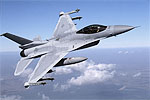NORAD: Jets need upgrades now to protect against cruise missiles
 The commander in charge of homeland defense signed an order to upgrade his F-16s with a specific threat in mind: cruise missiles headed into the U.S.
The commander in charge of homeland defense signed an order to upgrade his F-16s with a specific threat in mind: cruise missiles headed into the U.S.
North American Aerospace Defense Command earlier this year issued an urgent operational need request for new active electronically scanned array radar for F-16s tasked with protecting the homeland. The service is moving quickly on the request, with the goal of installing the systems first on F-16s tasked with protecting the National Capital Region.
Adm. Bill Gortney, commander of NORAD and U.S. Northern Command, said Tuesday he signed off on the urgent request because of the increased need to protect the homeland from cruise missiles. The radars work with other systems, such as Aegis Combat Systems and the Army's Joint Land Attack Cruise Missile Defense Elevated Netted Sensor System to identify cruise missiles from long distances.
"I know how effective [cruise missiles] are, and I know how hard they are to shoot down," Gortney said at a Pentagon briefing. "And so you need a system of systems in order to do that.''
The Air National Guard F-16s would be tasked with the airborne function of tracking cruise missile threats, and the upgraded radars would be necessary to detect fast-moving threats at range, to track and take out the source of the missiles.
"The best way to defeat the cruise missile threat is to shoot down the archer, or sink the archer, that's out there," Gortney said. "And that's what we need to be able to do. Just like in ballistic missile defense, start knocking down the archers at range, and you are only dealing with fewer missiles as they come at you."
There is no timeline for the radars in the National Capital Region F-16s to become active. Air Force leaders have said these jets would be first to receive the new systems, followed by other F-16s tasked with homeland defense, and then the entire F-16 fleet.
The Air Force has estimated it would cost $3.2 million per jet to install the new systems.
"Those elements are falling in place here in the National Capital Region and we expect to move forward to provide a rapid capability there first, and then see how we could expand it across the country," Lt. Gen. James Holmes, deputy chief of staff for strategic plans and requirements, told a House panel last month.
The upgrades were originally part of a larger upgrade and service-life extension package for all Air Force F-16s, but the plan was shelved following budget restrictions imposed by the Budget Control Act.
Air Force Chief of Staff Gen. Mark Welsh told the House Armed Services Committee last month that he wants to see the capability, which is already in place in the service's F-15s, available for all F-16s.
"We need to develop an AESA radar plan for our F-16s who are conducting the homeland defense mission in particular," Welsh said. "Our entire fleet — active, Guard and Reserve — none of them have been upgraded with that radar."